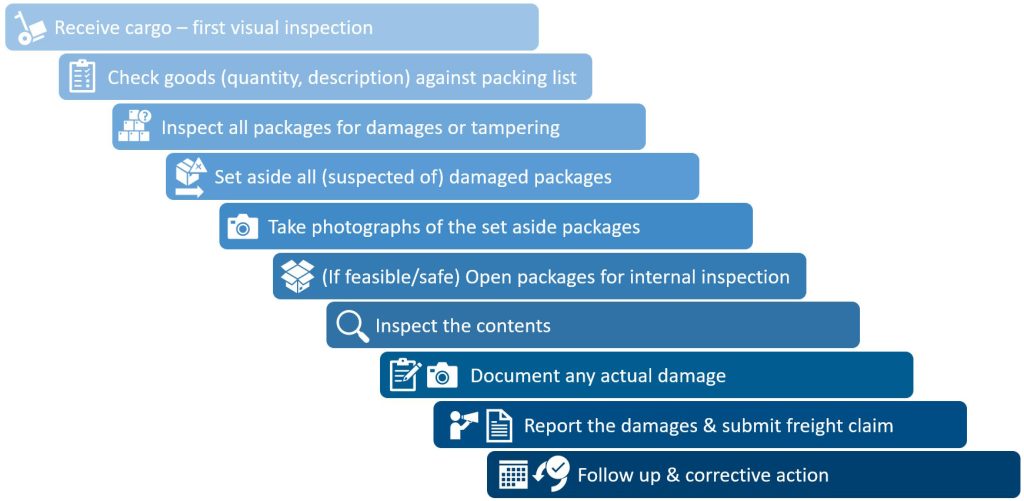Handling damaged cargo efficiently is crucial for any logistics operation. Properly managing freight claims can save your business time and money, and maintain customer satisfaction.
The graphic below illustrates the key steps in the process of handling damaged cargo and submitting freight claims.

These steps provide a structured approach to inspecting, documenting, and reporting damage, as well as following up on claims and implementing corrective actions. Each step is essential to ensuring that any damage is managed efficiently and claims are processed smoothly and in the following section, we will highlight certain points and add important information to help you understand how to effectively manage damaged cargo and freight claims.
1. Inspect cargo promptly: Upon receipt, immediately inspect cargo for any visible or hidden damage. Begin by examining the condition of packages while they are still inside the transport truck. Look for signs of movement, tilting, or damage that may have occurred during transit. Note any irregularities such as unusual noises, broken pallets, or visible damage to the exterior of the packages.
For packages showing visible damage or suspicion, conduct a detailed inspection immediately. Open these packages, documenting any damage with detailed notes and photographs.
Many pallets with intact packaging are moved to storage without inspection, but it’s crucial to inspect those with potential issues for immediate inspection and ideally a maximum of pallets regarding of their status should be inspected, unpacked before the end of the carrier’s claim tolerance window.
2. Document and report damage: If any damage is found, take detailed notes and photographs. Notify the carrier and shipper immediately. Annotate the Bill of Lading with any visible damage before signing.
3. Understand tolerance windows: Most carriers provide a tolerance window for reporting concealed damage, typically ranging from 5 to 15 days. It is essential to file a claim within this window to ensure it is processed.
4. File a claim promptly: Within the tolerance window, document the damage, notify the carrier and shipper, and file a freight claim with all documented evidence. Make sure to keep all packaging materials as they may be required for the claim process.
5. Post-tolerance window actions: If damage is discovered after the tolerance window, document the damage and the date of discovery. Review the purchase agreement terms, notify the carrier and shipper, and consider possible actions such as filing an insurance claim, negotiating with the shipper, or legal action if necessary.
6. Follow-up and corrective actions: After filing a claim, follow up regularly with the carrier and insurer to ensure that the claim is being processed. Keep track of all communications and document any updates or changes. Implement corrective actions based on the findings to prevent future occurrences. This could include reviewing and improving packaging methods, training staff on proper handling procedures, or working with carriers to ensure better handling of cargo.
7. Customer management: Maintain clear and proactive communication with your customers. Ensure timely updates and transparency regarding any issues with their cargo. Efficiently resolving issues is key to upholding customer satisfaction and trust.
Proper handling and timely reporting of damaged cargo are crucial to protecting your interests and ensuring successful claims. By following these guidelines, you can effectively manage any issues that arise and maintain the integrity of your logistics operations. Additionally, proactive customer management is key to maintaining satisfaction and trust.
Below is a short video presenting these steps – an extractfrom our course Handling Damaged Cargo.
Stay informed – subcribe to our newsletter here to be notified when our upcoming course “HANDLING DAMAGED CARGO EFFICIENTLY” is published and to miss out on other updates and valuable insights.
What to read next – What are linear feet or meters?

